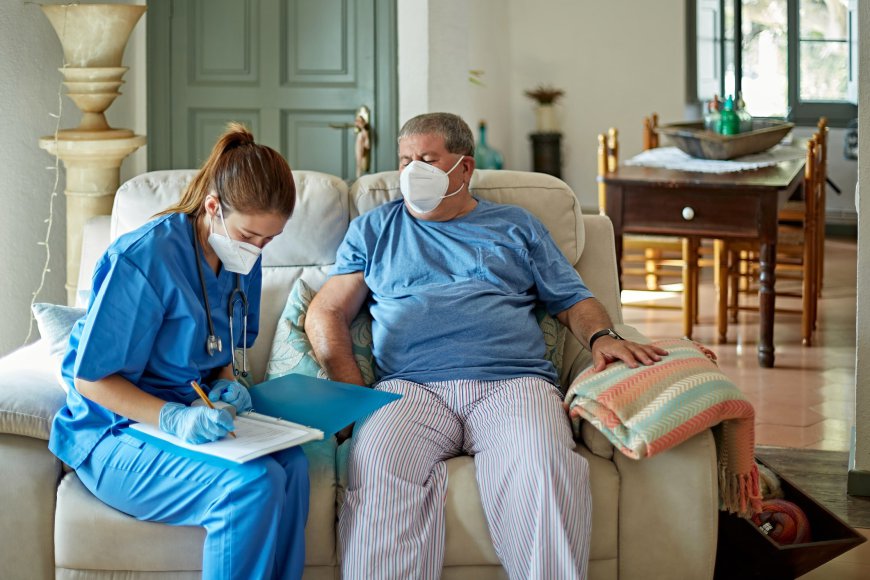How to Prepare Your Home for Professional Healthcare Services
Home Health Care in Dubai & Abu Dhabi provides a wide range of Home Healthcare facilities in the comfortable environment of your home for your convenience.

Professional healthcare services at home have become a convenient and vital option for those recovering from illness, managing chronic conditions, or requiring specialized care. Preparing your home for these services ensures a safe and comfortable environment for both the healthcare provider and the patient. Here's a step-by-step guide to get your home ready for professional healthcare services.
Assess the Space and Create a Dedicated Care Area:
Before any Home Healthcare in Dubai professional arrives, identify a specific area in your home to serve as the primary care space. This could be the patient’s bedroom or another easily accessible location. The space should:
- Be spacious enough for medical equipment and for the caregiver to move around easily.
- Have proper lighting to ensure the caregiver can perform tasks such as administering medications or monitoring vital signs.
- Be quiet and private, minimizing distractions and ensuring the patient's comfort and dignity.
If mobility is an issue, choose a ground-floor room to avoid difficulties with stairs.
Ensure Accessibility and Safety:
Safety is paramount when preparing your home for healthcare services. Take these precautions:
- Declutter: Remove unnecessary furniture, loose rugs, and other items that could cause tripping hazards.
- Install grab bars and handrails in areas like bathrooms or hallways for additional support.
- Use non-slip mats in bathrooms and around sinks to prevent falls.
- Check lighting: Ensure hallways, staircases, and the care area are well-lit. Consider nightlights for better visibility during nighttime.
For homes with narrow hallways or small doorways, check if they can accommodate wheelchairs or medical equipment.
Set Up Medical Equipment and Supplies:
If the care involves medical devices such as oxygen tanks, monitors, or hospital beds, set them up in advance. Work with your healthcare provider to understand the required equipment and follow these steps:
- Arrange for delivery and installation of large items like hospital beds or recliner chairs.
- Organize medical supplies such as syringes, bandages, and medications in a clean, accessible spot near the care area.
- Check power outlets: Ensure there are enough electrical outlets for powered medical equipment. Use surge protectors if necessary.
Establish a Cleaning and Hygiene Routine:
A clean environment is essential to prevent infections, especially for patients with weakened immune systems. Prepare by:
- Cleaning the care area thoroughly: Dust, vacuum, and sanitize surfaces regularly.
- Washing linens and clothing in hot water to kill germs.
- Keeping hand sanitizers and gloves readily available for caregivers and visitors.
- Setting up a disposal system: Use designated bins for medical waste such as used bandages or needles, following local disposal regulations.
Organize the Patient’s Medications:
Proper medication management is critical in home healthcare. Here’s how to organize it:
- Use a medication organizer: Arrange pills by day and time to avoid confusion.
- Create a medication schedule: Include the names, dosages, and timings for all medications.
- Store medications correctly: Some medications require refrigeration, while others need a cool, dry place.
- Dispose of expired drugs: Clear out old medications to prevent accidental use.
Prepare for Emergencies:
Having a plan for emergencies ensures quick and effective responses. Consider the following:
- Keep emergency contact numbers (e.g., doctors, the healthcare agency, and family members) in a visible place, like on the fridge or near the patient’s bed.
- Maintain a first aid kit with basic supplies like bandages, antiseptics, and gloves.
- Provide clear instructions for calling emergency services: Make sure everyone in the household knows how to communicate the patient’s condition to responders.
- Equip your home with a fire extinguisher and smoke alarms.
Coordinate Communication Channels:
Open and efficient communication with the healthcare provider ensures smooth service. Follow these steps:
- Share essential details: Provide the caregiver with a list of the patient’s medical history, allergies, and current medications.
- Create a communication logbook: Keep a notebook where caregivers can record daily observations, tasks completed, and any changes in the patient’s condition.
- Set up a point of contact: Assign one family member as the primary communicator with the healthcare provider.
Prepare the Household for the Caregiver’s Arrival:
When a professional caregiver visits your home, make their experience seamless and respectful:
- Introduce the caregiver: Inform family members and explain the caregiver’s role to avoid misunderstandings.
- Designate parking and entry instructions: Provide clear directions if your home has specific parking or security protocols.
- Respect their workspace: Allow them the room and privacy they need to perform their duties effectively.
Support the Patient’s Comfort and Emotional Well-being:
Creating a supportive environment for the patient can positively impact their recovery.
- Add personal touches: Incorporate familiar items like photographs, books, or a favorite blanket into the care space.
- Provide entertainment: Set up access to music, TV, or hobbies that the patient enjoys.
- Encourage family involvement: Regular visits or phone calls from loved ones can boost the patient’s morale.
Review and Adjust Regularly:
Home Healthcare needs can change over time. Regularly review your setup to ensure it continues to meet the patient’s requirements and the caregiver’s needs.
- Request feedback from the caregiver: They can offer suggestions to improve the care environment.
- Adapt to new medical needs: Be ready to add or adjust equipment and routines based on changes in the patient’s condition.
- Keep lines of communication open: Regularly discuss care plans with the healthcare provider.
Conclusion:
Preparing your home for professional healthcare services requires careful planning, but the effort ensures the patient receives the best care in a safe, comfortable, and well-organized environment. By assessing your space, prioritizing safety, and maintaining open communication, you create a setup that promotes recovery and well-being. With these preparations, you’ll foster a positive experience for both the patient and the caregiver.

 Royal Clinic
Royal Clinic